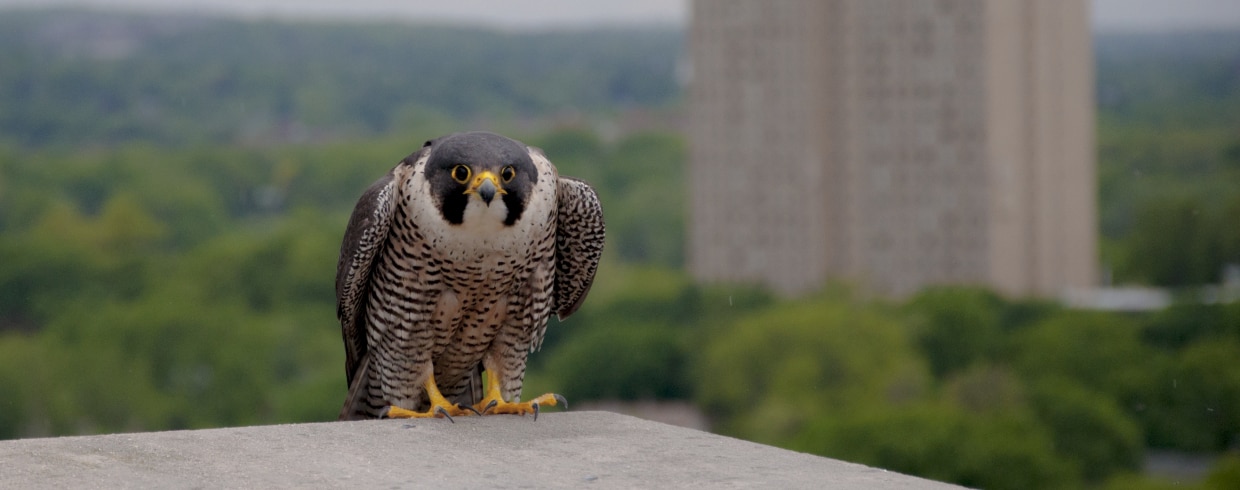Fast facts
Common name: Peregrine falcon
Scientific name: Falco peregrinus
Size: Males: 15–18 inches in length with a 35–42-inch wingspan; females: 18–20 inches in length with a 42–48-inch wingspan
Range: Every continent except Antarctica
Conservation status: Special concern in MA, not listed federally
Fun fact: Fastest bird on Earth with dive speeds over 240 mph
Description
Peregrine falcons are beautiful raptors. They have long, pointed wings and long, slightly rounded tails. Adults have a bluish-gray to slate-gray backside and a buffy white underside that is speckled with black. Adults also have a black crown and black mustache-like markings that look like sideburns. The throat is white. The bill is dark except for a prominent yellow fleshy base called a cere. The legs and feet are yellow. Immature peregrines have a brown backside and a heavily streaked underside.
Similar species: Cooper's hawks (Accipiter cooperii) are roughly the same size, build, and color to peregrine falcons. In the fall and winter, smaller merlins (Falco columbarius) and larger gyrfalcons (Falco rusticolus) may be confused with peregrine falcons, especially along the coast.
Population Status
As of 2020, at least 46 nesting pairs are known in Massachusetts. Before 2017, peregrine falcons were listed as endangered in Massachusetts. In 2019, their status in the state was improved to Special Concern. Peregrine falcons were removed from the Federal Endangered Species List in 1999.
Conservation
In the late 1940s, the effects of the pesticide DDT began taking their toll on peregrine falcons. Accumulation of DDT caused falcons and other birds to lay thin-shelled eggs that broke under the weight of incubation. The last historically active nest in Massachusetts was in 1955.
Restoration efforts began in 1972, coinciding with the ban of DDT. Attempts to release captive-bred chicks occurred in 1975–1979 with no success. In 1984 and 1985, young falcons were released in downtown Boston, successfully leading to the first modern Massachusetts nest in 1987. Since then, over 800 wild peregrine falcon chicks have fledged in Massachusetts.
MassWildlife has been banding and monitoring peregrine falcons since 1987. Staff use this information to track peregrines through an observer network to better learn about these protected birds.
Habitat
Historically, peregrine falcons nesting sites—called eyries—within Massachusetts were located on rocky cliffs. Of the 14 historical cliff nest sites, peregrine falcons have returned to only 5 of them: Mount Tom, Mount Sugarloaf, Farley Cliffs, Monument Mountain, and Pettibone Falls. Peregrine falcons also nest on the cliffs of quarries in Holyoke, West Roxbury, Saugus, Peabody, and Swampscott.
Now, peregrine falcons nest most frequently on tall man-made structures like buildings and bridges. Buildings that have consistent peregrine falcon nests can be found in Boston, Chelsea, Cambridge, Watertown, Lawrence, Lowell, Worcester, Amherst, and New Bedford. They nest on bridges in Charlestown, Fall River, West Springfield, and Northampton.
During the spring and early summer, get an insider view on some of the peregrine nests in Massachusetts.
Life history
Adults generally live about 10 years. The longest known lifespan of a peregrine falcon was 17 years.
Most peregrine falcons nest at 2–3 years old. Once they are established, adults remain in their territory throughout the year. By March 1, adult pairs choose their nest site for the season. By the beginning of April, 4–5 eggs are laid. The chicks hatch in early May and fledge—leave the nest—in mid-June. By the beginning of August, chicks become independent of their parents. During their first fall and winter, young peregrine falcons disperse around New England finding territories of their own.
Peregrine falcons are specially adapted to capture birds in flight. Their best known hunting strategy is to soar high over their territory and wait for a bird to fly past far below. They then dive straight down in a controlled dive called a stoop, where they can reach speeds over 240 miles per hour. The small bird flying below does not even know that it was targeted.
In Massachusetts, peregrine falcons almost exclusively hunt for other birds. The most frequent prey species include pigeons (rock doves), blue jays, and European starlings.
More information
Learn more about peregrine falcons with our fact sheet.
Get an overview of the Massachusetts Endangered Species Act.
